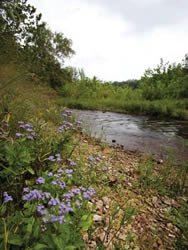Little Niangua River facts for kids
Quick facts for kids Little Niangua River |
|
|---|---|

The Little Niangua River running through Fiery Fork Conservation Area.
|
|
| Country | United States |
| State | Missouri |
| Physical characteristics | |
| Main source | Dallas County, Missouri 1,179 ft (359 m) 37°44′55″N 93°01′15″W / 37.74861°N 93.02083°W |
| River mouth | Lake of the Ozarks Camden County, Missouri 663 ft (202 m) 38°04′17″N 92°54′24″W / 38.07139°N 92.90667°W |
| Length | 64 mi (103 km) |
| Basin features | |
| Basin size | 320 sq mi (830 km2) |
| Watersheds | Little Niangua-Niangua-Osage-Missouri-Mississippi |
The Little Niangua River is a cool river in the Ozarks region of central Missouri, United States. It's about 64 miles (103 km) long. This river is a smaller branch, or tributary, of the Niangua River. All its water eventually flows into the huge Mississippi River. It's called "Little Niangua" because it's smaller than the main Niangua River.
Where the River Flows
The Little Niangua River starts in Dallas County, Missouri. From there, it flows mostly northeast. It travels through Hickory County, Missouri and Camden County, Missouri.
The river then joins the Niangua River in Camden County. This meeting point is part of the Lake of the Ozarks. The Lake of the Ozarks is a large lake created by a dam on the Osage River.
Special Fish: The Niangua Darter
The upper parts of the Little Niangua River are home to a very special fish. This fish is called the Niangua darter. It's a small fish that lives in these waters.
Some of its favorite spots include smaller streams like Cahoochie Creek and Thomas Creek. These are both found in Dallas County, Missouri. The Niangua darter is on the U.S. Fish and Wildlife Service's list of Endangered species. This means it's a rare animal that needs our help to survive.
Places to Visit
There are many places where you can easily get to the Little Niangua River. These spots are called "river accesses." They are great for enjoying the river.
Some popular access points include Bannister Hollow and Fiery Fork Conservation Area. You can also find access where roads cross over the river. These areas are perfect for exploring and enjoying nature.

